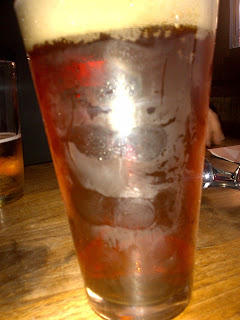What would President Herbert Hoover -- who coined the term referring to a certain contemptible constitutional amendment -- think about Bridget Firtle naming her distillation operation "Noble Experiment"? We're not sure if making rum is particularly "noble", but it's certainly appreciated!
 |
| Bridget and Bill. |
Bridget was a guest speaker at the June 2013 meeting of the Malted Barley Appreciation Society, which is a slightly funny coincidence, since she, herself, holds an MBA. Until recently, she was using her degree working as a global alcoholic beverage financial analyst for a hedge fund, researching and investing in beer, wine and spirits companies. In that capacity she was introduced to the world of craft spirits and, inspired by some of the finer artisans, she decided that it would be more satisfying to become a maker of fine spirits than simply to invest in them.
 |
Column still on the left, pot still on the right.
|
Presaging her radical career swing, her childhood home in the Rockaways was also home to a basement speak easy during Prohibition. The original bar still stands to this day -- despite extensive damage to the house during hurricane Sandy! And it was in her Rockaways neighborhood where notorious bootlegger, Gopher Gang member and rum runner Owney "The Killer" Madden had an estate near the water, which facilitated his conveyance of illegal booze from ships off shore to places like the Cotton Club, which he ran during Prohibition.

 A homage to Madden, Noble Experiment's first commercial offering, released at the end of 2012, is a white rum called Owney's. White rum is not aged in wood. It's the wood and wood alone that gives spirits their color, unless, of course, caramel or other coloring is added. Hers is made with all natural, non-GMO, grade-A molasses (about 70% sugar content) from Louisiana and Florida, and fermented with a propitiatory yeast strain. It undergoes a five-day cold fermentation in temperature controlled tanks, as opposed to a 48-hour, hot fermentation, which is the common method. Then the beer/wine-like liquor is distilled in a pot-column hybrid still to about 80-85% ABV before being brought down to 80 proof, or 40% ABV in the bottle.
A homage to Madden, Noble Experiment's first commercial offering, released at the end of 2012, is a white rum called Owney's. White rum is not aged in wood. It's the wood and wood alone that gives spirits their color, unless, of course, caramel or other coloring is added. Hers is made with all natural, non-GMO, grade-A molasses (about 70% sugar content) from Louisiana and Florida, and fermented with a propitiatory yeast strain. It undergoes a five-day cold fermentation in temperature controlled tanks, as opposed to a 48-hour, hot fermentation, which is the common method. Then the beer/wine-like liquor is distilled in a pot-column hybrid still to about 80-85% ABV before being brought down to 80 proof, or 40% ABV in the bottle.
During her talk,
she explained that rum is the most loosely defined spirit. To be called
rum, a distillate need only be made from the sugar cane plant. Rum made from sugar cane juice, as opposed to molasses -- a by-product of sugar refining -- is called "Rhum Agricole". The juice ferments on its own within three days, so it can't be shipped or stored, making molasses a more logical choice for making rum in New York.
Bridget has plans of aging her rum in various different barrels: new whiskey barrels, used whiskey barrels, wine barrels, different types of oak. In addition to the rum, she plans on also distilling whiskey, and already has one barrel of rye now aging in the barrel.
With Noble Experiment, and Owney's in particular, Bridget is trying to bring back good ol' American rum, which was the first spirit distilled in New York in the 1600s on what is current day Staten Island. And she's not the only one trying to revive local distilling. In 2002 -- the first time that New York State even offered a small distiller's license -- four distilleries operated in the City. Today there are at least 10 distilleries in Brooklyn alone!

Noble Experiment non-Flash podcast
 |
| Jakob of Mikkeller, Bill and Bridget. |
 Carol Stoudt podcast (non-Flash)
Carol Stoudt podcast (non-Flash)










































